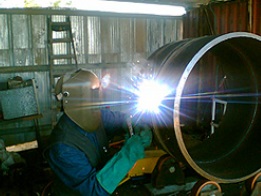Naturally, materials returning to their basic condition and loosing their strength as long they exist and used.
The concerned questions are when and how the failure cause?
For the second question the answer can be found by investigating the and implemention conclusion on simillar part at the future.
But what if the part is allready failed and been cracked?
To remove any doubt, we perform NonDestractive Tests (NDT) witch allows us to examine the inspected part quality and condition
- Detect internal and external imperfections.
- Discover internal structure of sealed parts without opening them or cause any damage.

Usually NDT performs at 3 appointed times:
1. Examination during manufacturing
The inspection are performing, following safty and economic considerations according to parts duty and investigation the damage that might cause if the part will fail.
In some cases 100% of the manufactured parts are examine and in other cases only sample, base on statistical calculation.
The inspections performes on castings, strengthenings, CNC manufactured parts, welds, pipes, silos, boilers and more.
Weld examination has 5 steps:
- Welding Procedure Specification (WPS) writing.
- WPS approving.
- Procedure Qualification Record (PQR), WPS practical test.
- Welder test and qualifacation following WPS details.
- Weld inspection according to accepted standards.
2. Interval inspections of in-used parts:
Usually performs on parts with safty disposing as aviation parts or parts that we concern they will fail due to continusly cyclly stress.
The inspections performs during machine maintanence.
The intervals determines by the part duty.
The inspections performs for detecting wall thickness decreasing, cracks progression and more.
3. Inspection after repairment:
These inspections usually refers to parts that have been repaired by welding or any other way, while treating the repaired partas a new manufactured part.
Examples of faults are Termical shock, falling, phisical hit etc.
Accepted standards:
- Presure tanks – ASME VIII
- Opened tanks – API 620, API 650
- Pipes – ASME B31.3, API 1104
- Constractions – AWS D1.1

